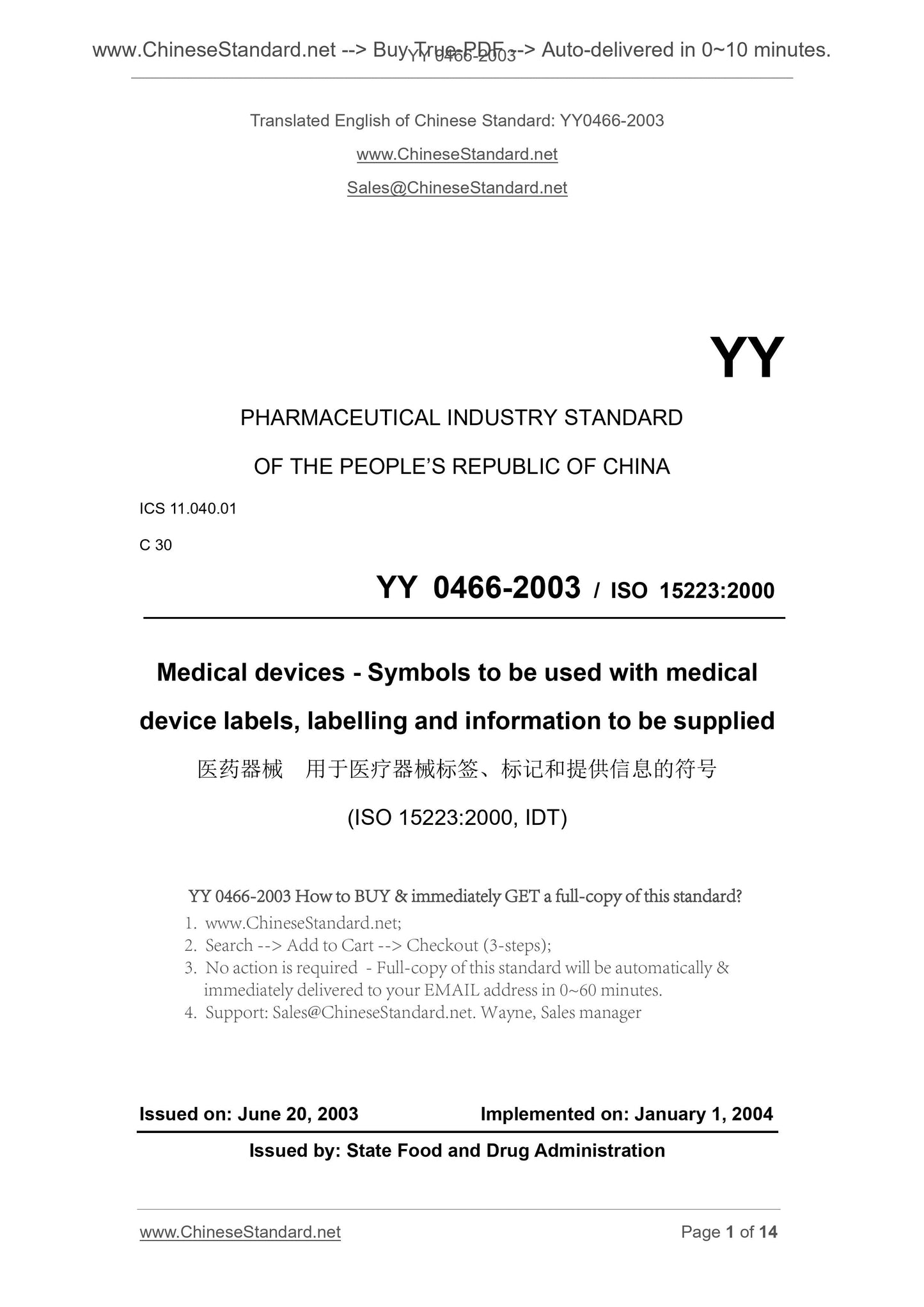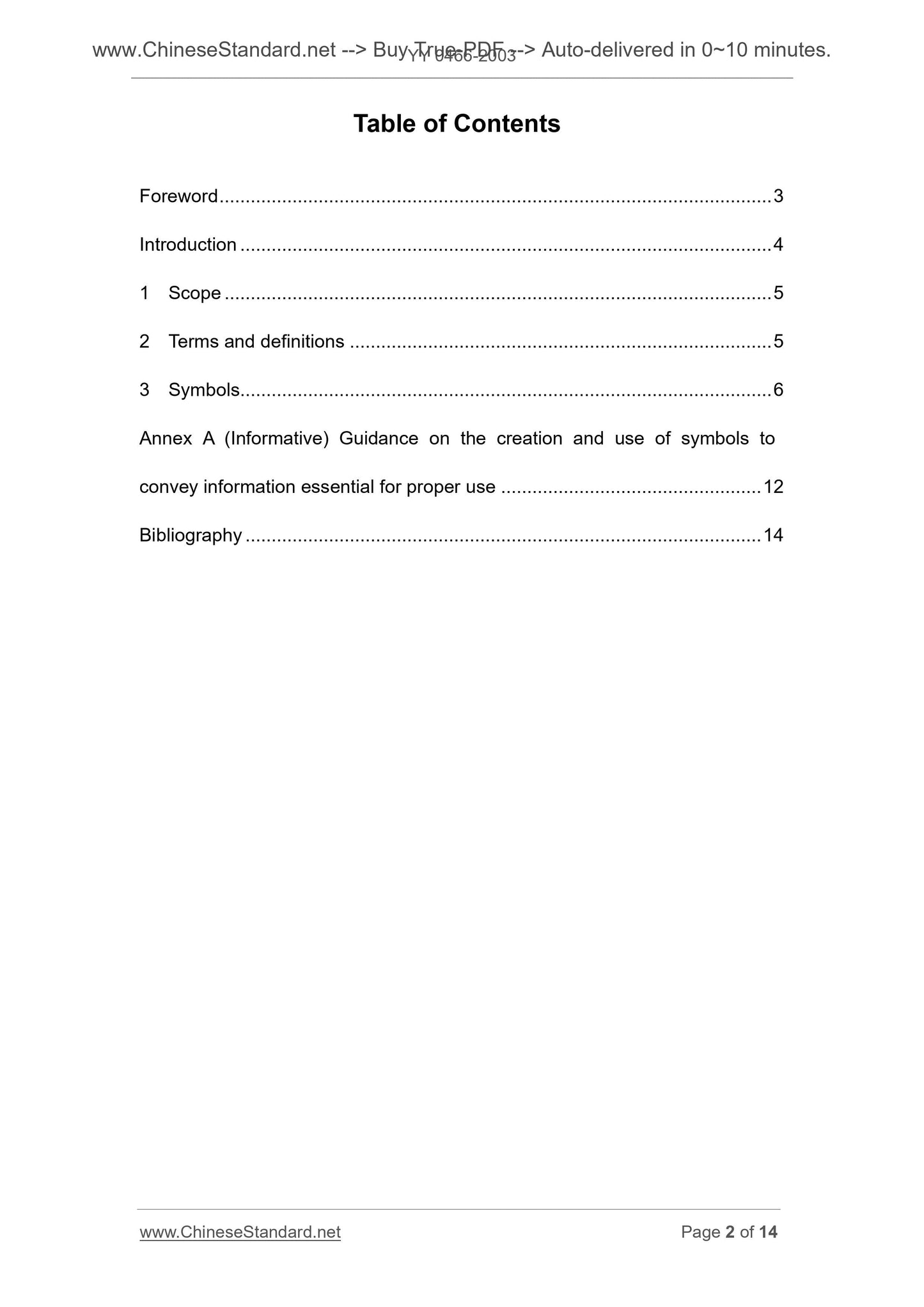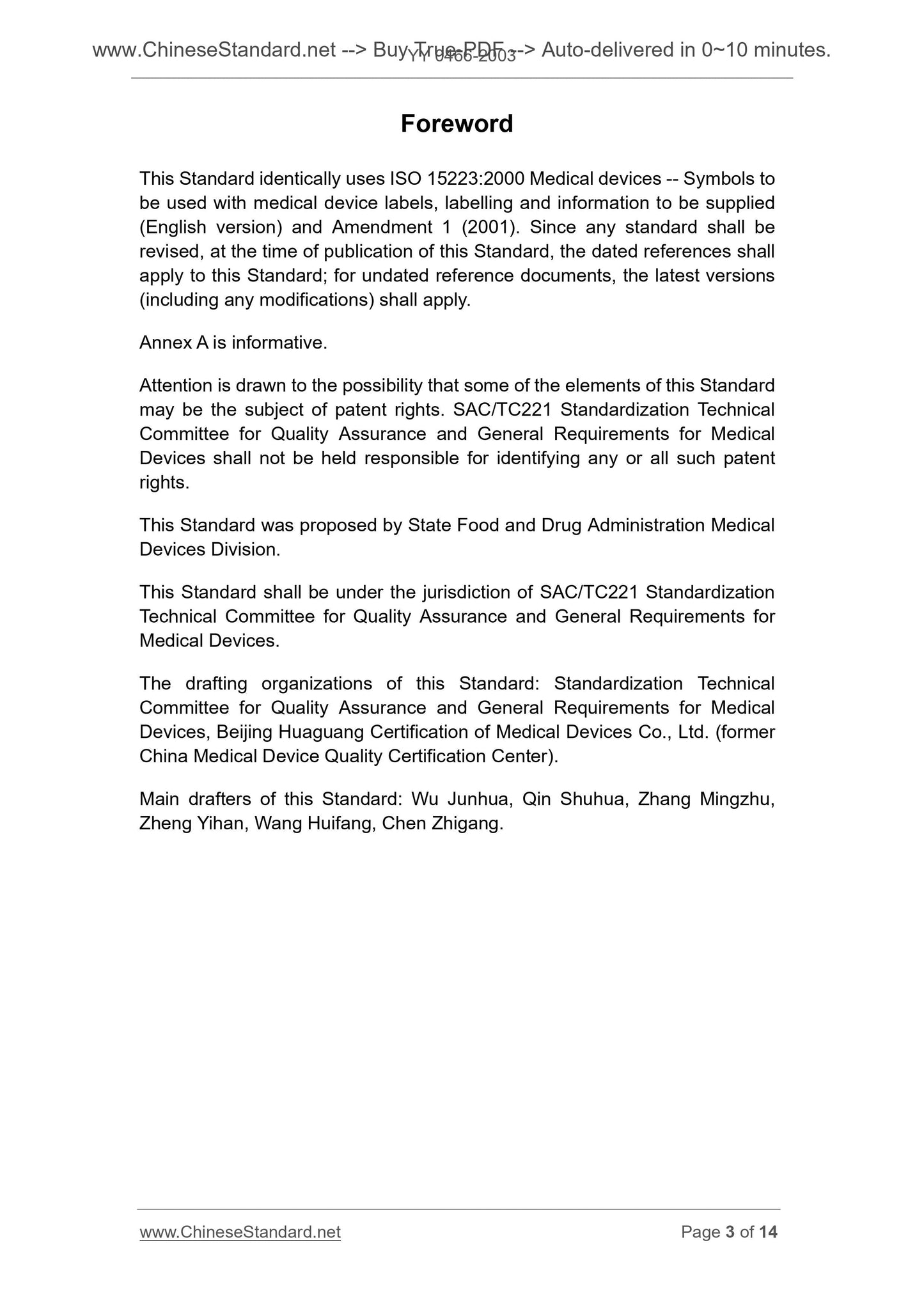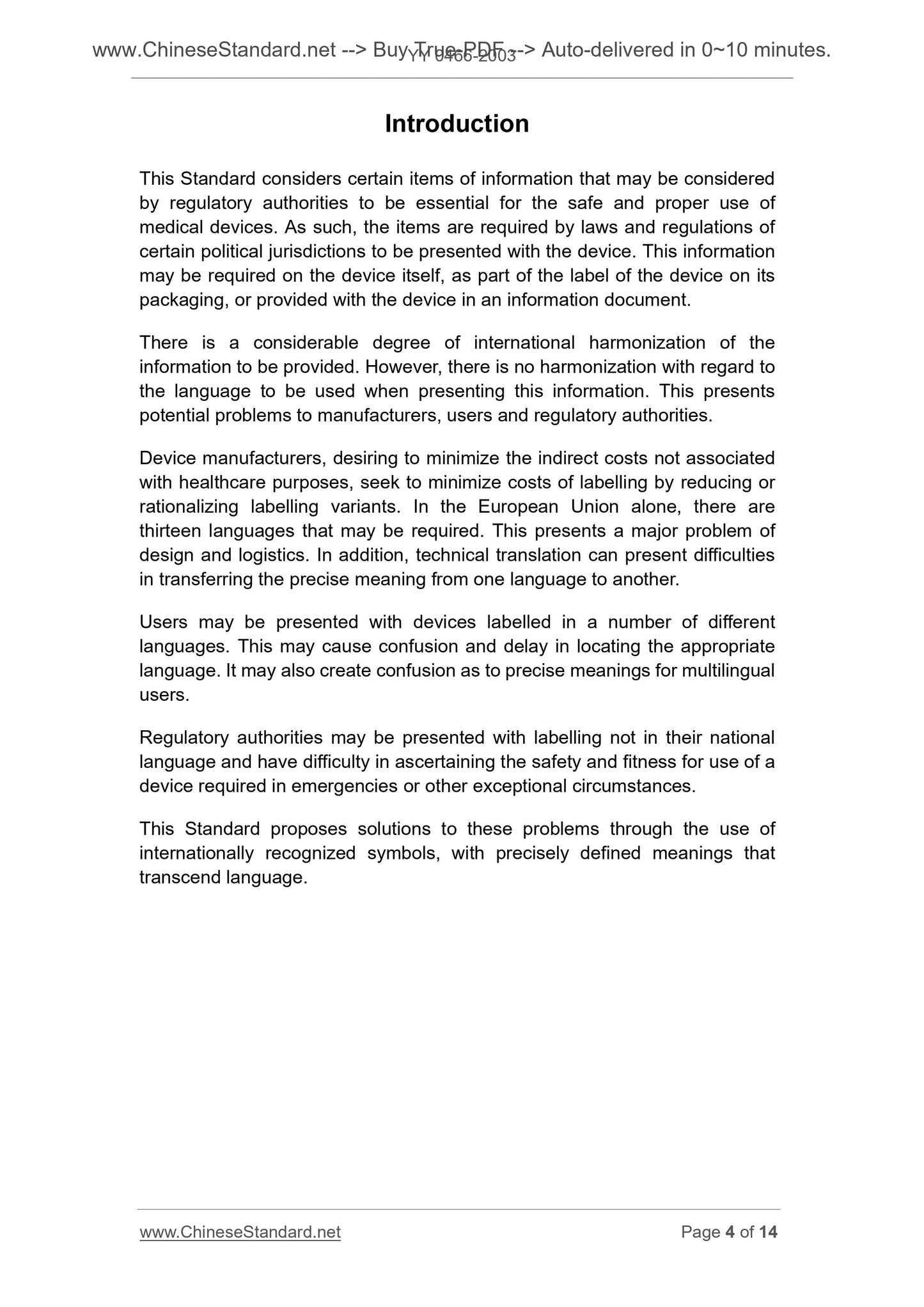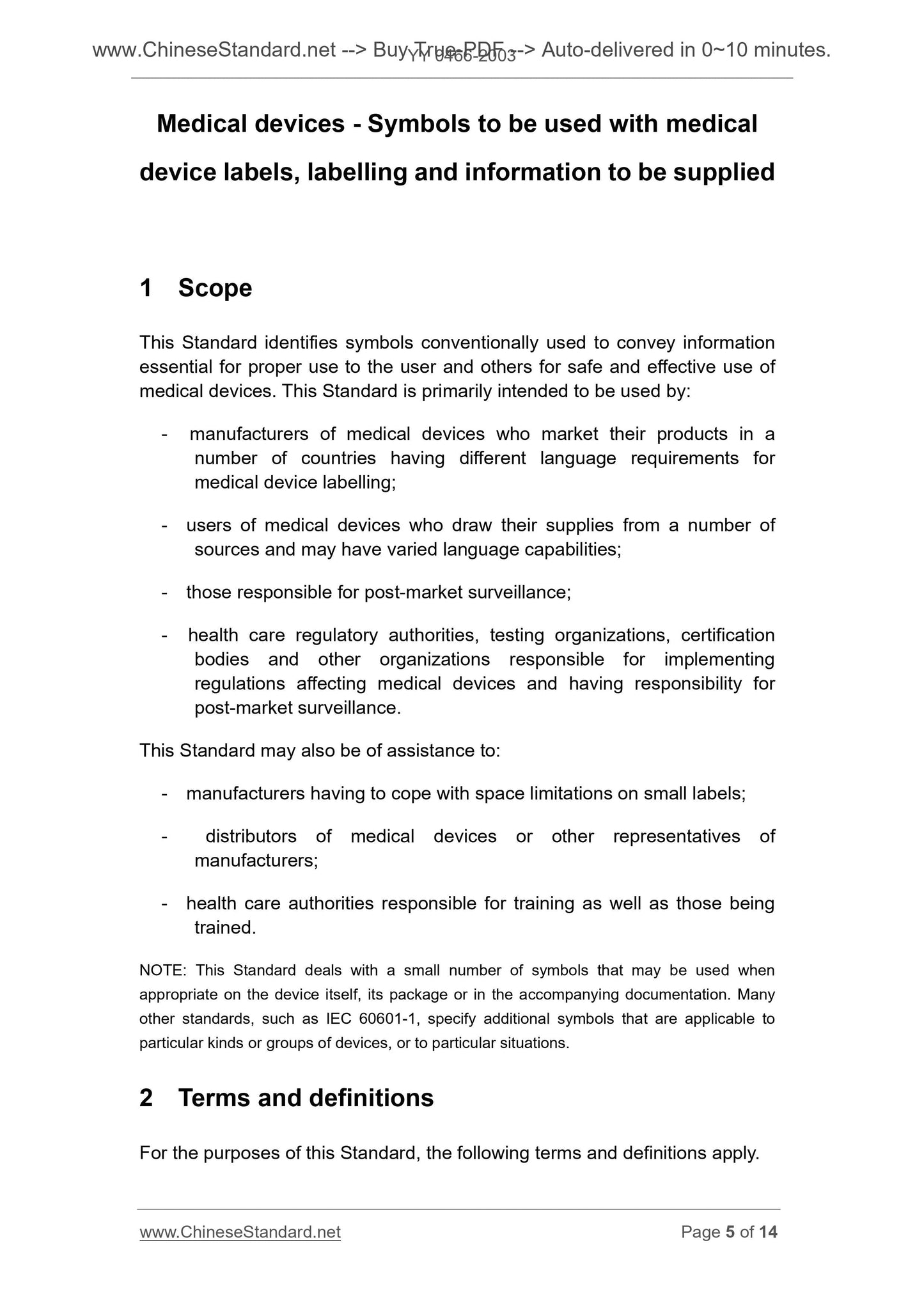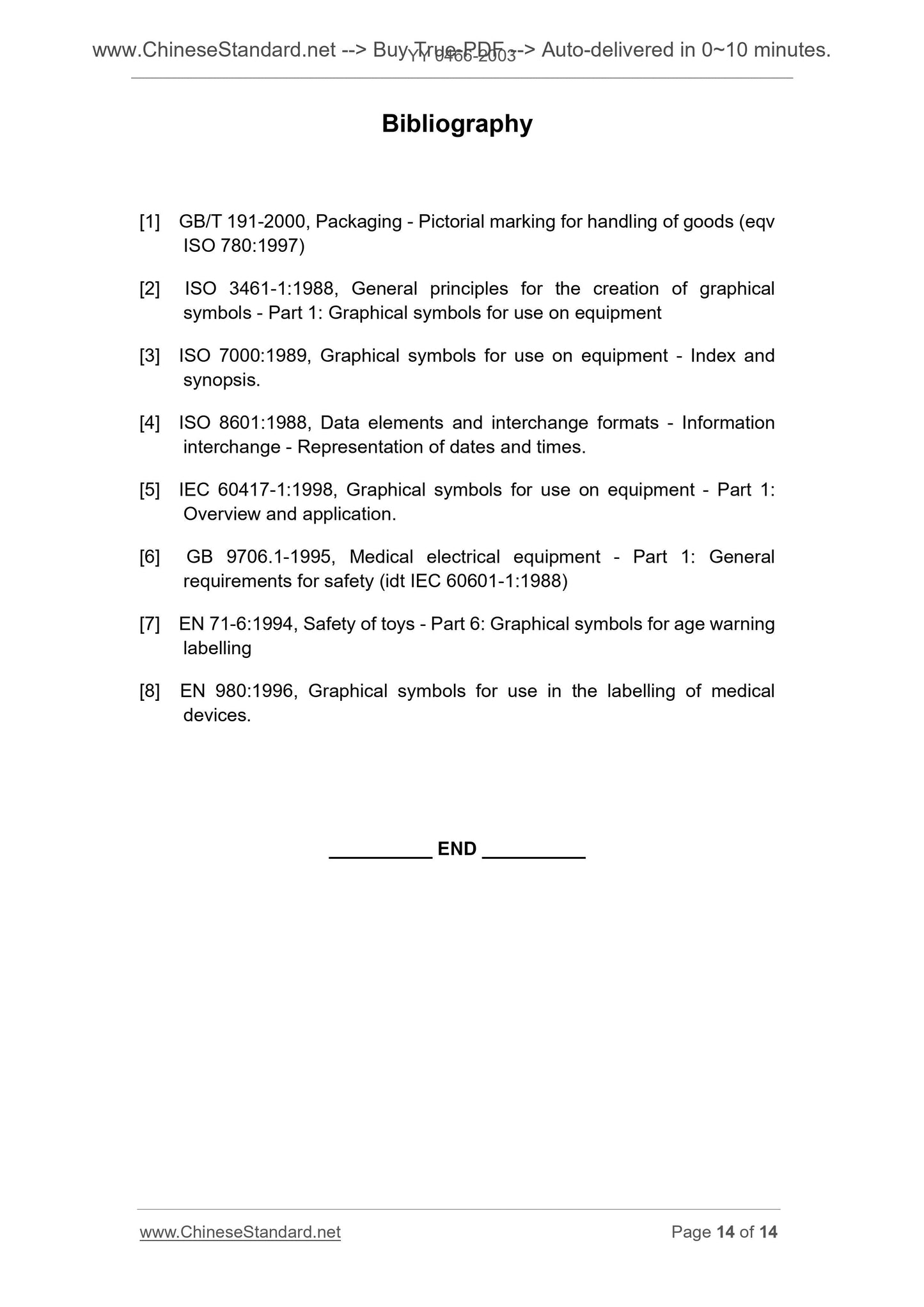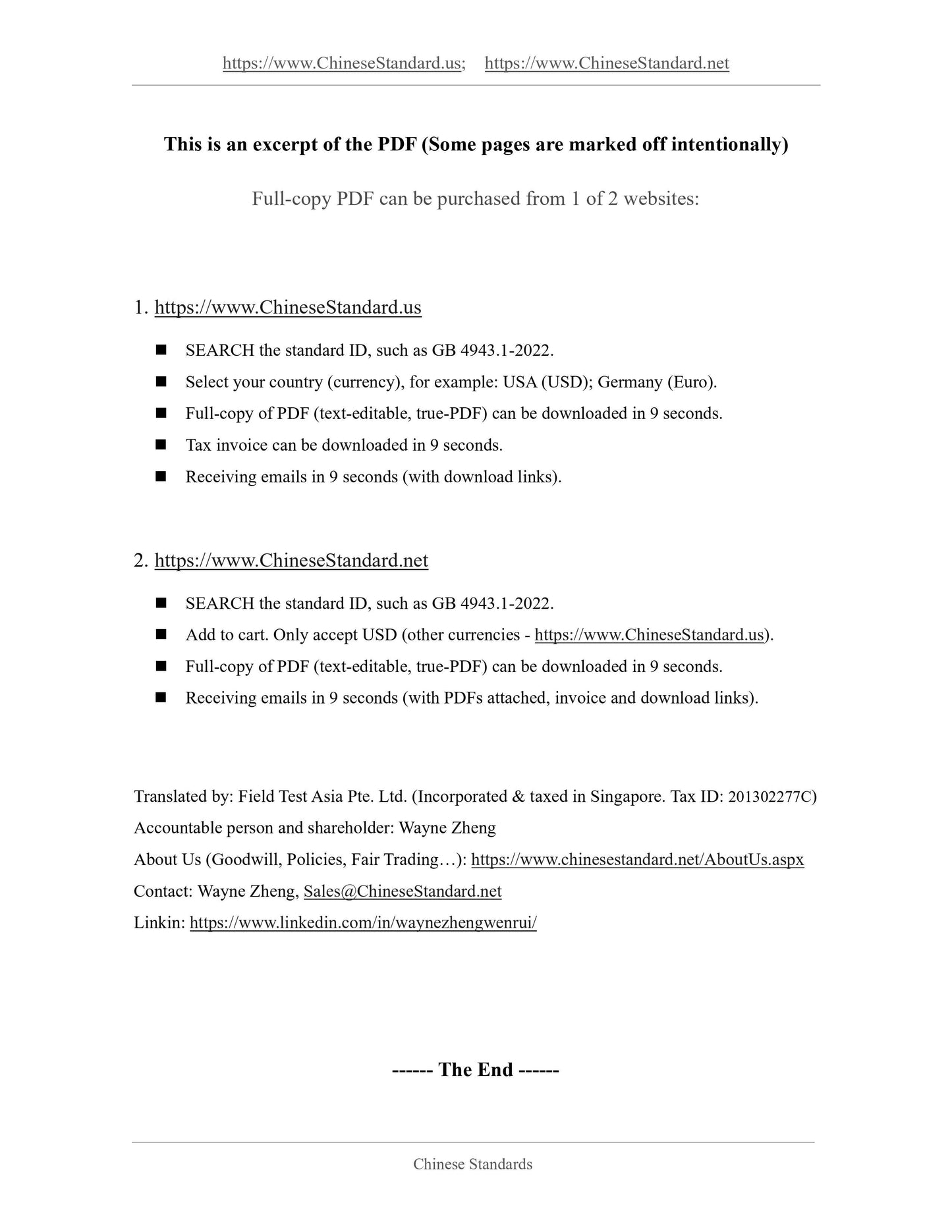1
/
of
7
PayPal, credit cards. Download editable-PDF and invoice in 1 second!
YY 0466-2003 English PDF (YY0466-2003)
YY 0466-2003 English PDF (YY0466-2003)
Regular price
$140.00 USD
Regular price
Sale price
$140.00 USD
Unit price
/
per
Shipping calculated at checkout.
Couldn't load pickup availability
Delivery: 3 seconds. Download true-PDF + Invoice.Newer version: (Replacing this standard) YY/T 0466.1-2023
Get QUOTATION in 1-minute: Click YY 0466-2003
Historical versions: YY 0466-2003
Preview True-PDF (Reload/Scroll if blank)
YY 0466-2003: Medical devices-Symbols to be used with medical device labels, labelling and information to be supplied
YY 0466-2003
YY
PHARMACEUTICAL INDUSTRY STANDARD
OF THE PEOPLE’S REPUBLIC OF CHINA
ICS 11.040.01
C 30
YY 0466-2003 / ISO 15223.2000
Medical devices - Symbols to be used with medical
device labels, labelling and information to be supplied
(ISO 15223.2000, IDT)
ISSUED ON. JUNE 20, 2003
IMPLEMENTED ON. JANUARY 1, 2004
Issued by. State Food and Drug Administration
3. No action is required - Full-copy of this standard will be automatically and
immediately delivered to your EMAIL address in 0~60 minutes.
Table of Contents
Foreword ... 3
Introduction ... 4
1 Scope ... 5
2 Terms and definitions ... 5
3 Symbols... 6
Annex A (Informative) Guidance on the creation and use of symbols to
convey information essential for proper use ... 12
Bibliography ... 14
Foreword
This Standard identically uses ISO 15223.2000 Medical devices -- Symbols to
be used with medical device labels, labelling and information to be supplied
(English version) and Amendment 1 (2001). Since any standard shall be
revised, at the time of publication of this Standard, the dated references shall
apply to this Standard; for undated reference documents, the latest versions
(including any modifications) shall apply.
Annex A is informative.
Attention is drawn to the possibility that some of the elements of this Standard
may be the subject of patent rights. SAC/TC221 Standardization Technical
Committee for Quality Assurance and General Requirements for Medical
Devices shall not be held responsible for identifying any or all such patent
rights.
This Standard was proposed by State Food and Drug Administration Medical
Devices Division.
This Standard shall be under the jurisdiction of SAC/TC221 Standardization
Technical Committee for Quality Assurance and General Requirements for
Medical Devices.
The drafting organizations of this Standard. Standardization Technical
Committee for Quality Assurance and General Requirements for Medical
Devices, Beijing Huaguang Certification of Medical Devices Co., Ltd. (former
China Medical Device Quality Certification Center).
Main drafters of this Standard. Wu Junhua, Qin Shuhua, Zhang Mingzhu,
Zheng Yihan, Wang Huifang, Chen Zhigang.
Introduction
This Standard considers certain items of information that may be considered
by regulatory authorities to be essential for the safe and proper use of
medical devices. As such, the items are required by laws and regulations of
certain political jurisdictions to be presented with the device. This information
may be required on the device itself, as part of the label of the device on its
packaging, or provided with the device in an information document.
There is a considerable degree of international harmonization of the
information to be provided. However, there is no harmonization with regard to
the language to be used when presenting this information. This presents
potential problems to manufacturers, users and regulatory authorities.
Device manufacturers, desiring to minimize the indirect costs not associated
with healthcare purposes, seek to minimize costs of labelling by reducing or
rationalizing labelling variants. In the European Union alone, there are
thirteen languages that may be required. This presents a major problem of
design and logistics. In addition, technical translation can present difficulties
in transferring the precise meaning from one language to another.
Users may be presented with devices labelled in a number of different
languages. This may cause confusion and delay in locating the appropriate
language. It may also create confusion as to precise meanings for multilingual
users.
Regulatory authorities may be presented with labelling not in their national
language and have difficulty in ascertaining the safety and fitness for use of a
device required in emergencies or other exceptional circumstances.
This Standard proposes solutions to these problems through the use of
internationally recognized symbols, with precisely defined meanings that
transcend language.
Medical devices - Symbols to be used with medical
device labels, labelling and information to be supplied
1 Scope
This Standard identifies symbols conventionally used to convey information
essential for proper use to the user and others for safe and effective use of
medical devices. This Standard is primarily intended to be used by.
- manufacturers of medical devices who market their products in a
number of countries having different language requirements for
medical device labelling;
- users of medical devices who draw their supplies from a number of
sources and may have varied language capabilities;
- those responsible for post-market surveillance;
- health care regulatory authorities, testing organizations, certification
bodies and other organizations responsible for implementing
regulations affecting medical devices and having responsibility for
post-market surveillance.
This Standard may also be of assistance to.
- manufacturers having to cope with space limitations on small labels;
- distributors of medical devices or other representatives of
manufacturers;
- health care authorities responsible for training as well as those being
trained.
NOTE. This Standard deals with a small number of symbols that may be used when
appropriate on the device itself, its package or in the accompanying documentation. Many
other standards, such as IEC 60601-1, specify additional symbols that are applicable to
particular kinds or groups of devices, or to particular situations.
2 Terms and definitions
For the purposes of this Standard, the following terms and definitions apply.
Bibliography
[1] GB/T 191-2000, Packaging - Pictorial marking for handling of goods (eqv
ISO 780.1997)
[2] ISO 3461-1.1988, General principles for the creation of graphical
symbols - Part 1. Graphical symbols for use on equipment
[3] ISO 7000.1989, Graphical symbols for use on equipment - Index and
synopsis.
[4] ISO 8601.1988, Data elements and interchange formats - Information
interchange - Representation of dates and times.
[5] IEC 60417-1.1998, Graphical symbols for use on equipment - Part 1.
Overview and application.
[6] GB 9706.1-1995, Medical electrical equipment - Part 1. General
requirements for safety (idt IEC 60601-1.1988)
[7] EN 71-6.1994, Safety of toys - Part 6. Graphical symbols for age warning
labelling
[8] EN 980.1996, Graphical symbols for use in the labelling of medical
devices.
Get QUOTATION in 1-minute: Click YY 0466-2003
Historical versions: YY 0466-2003
Preview True-PDF (Reload/Scroll if blank)
YY 0466-2003: Medical devices-Symbols to be used with medical device labels, labelling and information to be supplied
YY 0466-2003
YY
PHARMACEUTICAL INDUSTRY STANDARD
OF THE PEOPLE’S REPUBLIC OF CHINA
ICS 11.040.01
C 30
YY 0466-2003 / ISO 15223.2000
Medical devices - Symbols to be used with medical
device labels, labelling and information to be supplied
(ISO 15223.2000, IDT)
ISSUED ON. JUNE 20, 2003
IMPLEMENTED ON. JANUARY 1, 2004
Issued by. State Food and Drug Administration
3. No action is required - Full-copy of this standard will be automatically and
immediately delivered to your EMAIL address in 0~60 minutes.
Table of Contents
Foreword ... 3
Introduction ... 4
1 Scope ... 5
2 Terms and definitions ... 5
3 Symbols... 6
Annex A (Informative) Guidance on the creation and use of symbols to
convey information essential for proper use ... 12
Bibliography ... 14
Foreword
This Standard identically uses ISO 15223.2000 Medical devices -- Symbols to
be used with medical device labels, labelling and information to be supplied
(English version) and Amendment 1 (2001). Since any standard shall be
revised, at the time of publication of this Standard, the dated references shall
apply to this Standard; for undated reference documents, the latest versions
(including any modifications) shall apply.
Annex A is informative.
Attention is drawn to the possibility that some of the elements of this Standard
may be the subject of patent rights. SAC/TC221 Standardization Technical
Committee for Quality Assurance and General Requirements for Medical
Devices shall not be held responsible for identifying any or all such patent
rights.
This Standard was proposed by State Food and Drug Administration Medical
Devices Division.
This Standard shall be under the jurisdiction of SAC/TC221 Standardization
Technical Committee for Quality Assurance and General Requirements for
Medical Devices.
The drafting organizations of this Standard. Standardization Technical
Committee for Quality Assurance and General Requirements for Medical
Devices, Beijing Huaguang Certification of Medical Devices Co., Ltd. (former
China Medical Device Quality Certification Center).
Main drafters of this Standard. Wu Junhua, Qin Shuhua, Zhang Mingzhu,
Zheng Yihan, Wang Huifang, Chen Zhigang.
Introduction
This Standard considers certain items of information that may be considered
by regulatory authorities to be essential for the safe and proper use of
medical devices. As such, the items are required by laws and regulations of
certain political jurisdictions to be presented with the device. This information
may be required on the device itself, as part of the label of the device on its
packaging, or provided with the device in an information document.
There is a considerable degree of international harmonization of the
information to be provided. However, there is no harmonization with regard to
the language to be used when presenting this information. This presents
potential problems to manufacturers, users and regulatory authorities.
Device manufacturers, desiring to minimize the indirect costs not associated
with healthcare purposes, seek to minimize costs of labelling by reducing or
rationalizing labelling variants. In the European Union alone, there are
thirteen languages that may be required. This presents a major problem of
design and logistics. In addition, technical translation can present difficulties
in transferring the precise meaning from one language to another.
Users may be presented with devices labelled in a number of different
languages. This may cause confusion and delay in locating the appropriate
language. It may also create confusion as to precise meanings for multilingual
users.
Regulatory authorities may be presented with labelling not in their national
language and have difficulty in ascertaining the safety and fitness for use of a
device required in emergencies or other exceptional circumstances.
This Standard proposes solutions to these problems through the use of
internationally recognized symbols, with precisely defined meanings that
transcend language.
Medical devices - Symbols to be used with medical
device labels, labelling and information to be supplied
1 Scope
This Standard identifies symbols conventionally used to convey information
essential for proper use to the user and others for safe and effective use of
medical devices. This Standard is primarily intended to be used by.
- manufacturers of medical devices who market their products in a
number of countries having different language requirements for
medical device labelling;
- users of medical devices who draw their supplies from a number of
sources and may have varied language capabilities;
- those responsible for post-market surveillance;
- health care regulatory authorities, testing organizations, certification
bodies and other organizations responsible for implementing
regulations affecting medical devices and having responsibility for
post-market surveillance.
This Standard may also be of assistance to.
- manufacturers having to cope with space limitations on small labels;
- distributors of medical devices or other representatives of
manufacturers;
- health care authorities responsible for training as well as those being
trained.
NOTE. This Standard deals with a small number of symbols that may be used when
appropriate on the device itself, its package or in the accompanying documentation. Many
other standards, such as IEC 60601-1, specify additional symbols that are applicable to
particular kinds or groups of devices, or to particular situations.
2 Terms and definitions
For the purposes of this Standard, the following terms and definitions apply.
Bibliography
[1] GB/T 191-2000, Packaging - Pictorial marking for handling of goods (eqv
ISO 780.1997)
[2] ISO 3461-1.1988, General principles for the creation of graphical
symbols - Part 1. Graphical symbols for use on equipment
[3] ISO 7000.1989, Graphical symbols for use on equipment - Index and
synopsis.
[4] ISO 8601.1988, Data elements and interchange formats - Information
interchange - Representation of dates and times.
[5] IEC 60417-1.1998, Graphical symbols for use on equipment - Part 1.
Overview and application.
[6] GB 9706.1-1995, Medical electrical equipment - Part 1. General
requirements for safety (idt IEC 60601-1.1988)
[7] EN 71-6.1994, Safety of toys - Part 6. Graphical symbols for age warning
labelling
[8] EN 980.1996, Graphical symbols for use in the labelling of medical
devices.
Share
